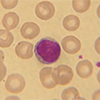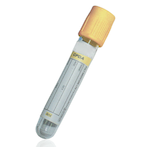
- Home
- Clinical Chemistry Tests
- Potassium (serum)
Potassium (serum)
Specimen Volume
2.0 mL bloodSample Preparation
Centrifuge - do not leave on cells overnight
Turnaround Time
1 daySample Processing In Laboratory
Usual
Sample Stability
14 days at 4°C
General Information
Potassium is the main intracellular cation. Small changes in the distribution of potassium can give rise to medical emergencies. The serum and urine concentrations of potassium reflect a complex interplay of hormonal and other systems that regulate the intracellular content. The main regulators of potassium concentrations in serum and urine are, insulin, aldosterone, catecholamines and acid base status. Diseases of the kidney, adrenal and any process that affects acid base disturbance will affect plasma potassium concentration. Crush injuries are also a cause of hyperkalaemia.
High potassium concentrations can give rise to a medical emergency requiring rapid intervention. Changes in potassium concentration affect the electrical conductivity of muscles and cardiac muscle and in high concentrations can cause cardiac arrest.
Patient Preparation
None
Notes
Samples left on cells and haemolysed samples will not be analysed
Note: Insulin, corticosteroids, furosemide, thiazides can decrease potassium. Potassium sparing diurectics, ACE inhibitors can increase potassium.
Reference Range
• Adults: 3.5 – 5.3 mmol/L
• Neonates: 3.4 – 6.0 mmol/L
• Infant: 3.5 – 5.7 mmol/L
• 1-16 years: 3.5 – 5.0 mmol/L
Source of Reference Range
Pathology HarmonySpecifications
-
EQA Status:
NEQAS
- EQAS Scheme: Yes
Related Tests
Bicarbonate Creatine Kinase (CK) Creatinine Glucose (Plasma) Magnesium (serum) Potassium (urine) SodiumCreation Date
Monday, 08 August 2011Modification Date
Thursday, 19 December 2019General Information
Location of Laboratories
Copyright UHB Pathology 2018
Protection of Personal Information – Clinical Laboratory Services comply with the Trust Data Protection Policy and have procedures in place to allow the Directorate and it’s employees to comply with the Data Protection Act 1998 and associated best practice and guidance.
University Hospitals Birmingham medical laboratories at Queen Elizabeth Hospital, Heartlands Hospital, Good Hope Hospital and Solihull Hospital are UKAS (United Kingdom Accreditation Service) accredited to the ISO 15189:2012 standard. For a list of accredited tests and other information please visit the UKAS website using the following link: https://www.ukas.com/find-an-organisation/
- Molecular Pathology is a UKAS accredited medical laboratory No. 8759
- Biochemistry is a UKAS accredited medical laboratory No. 8910
- Haematology and Transfusion is a UKAS accredited medical laboratory No. 8784
- Clinical Microbiology is a UKAS accredited medical laboratory No. 8760
- Cellular Pathology is a UKAS accredited medical laboratory No. 10141
- Musculoskeletal laboratory is a UKAS accredited medical laboratory No. 9897
- Heartlands, Good Hope and Solihull Hospital pathology laboratories are a UKAS accredited medical laboratory No.8217.
Tests not appearing on the UKAS Schedule of Accreditation currently remain outside of our scope of accreditation. However, these tests have been validated to the same high standard as accredited tests and are performed by the same trained and competent staff.
For further test information, please visit the test database: http://qehbpathology.uk/test-database
For further information contact Louise Fallon, Quality Manager, 0121 371 5962
 Biochemistry
Biochemistry Haematology and Transfusion
Haematology and Transfusion Clinical Microbiology (Including Virology)
Clinical Microbiology (Including Virology) Cellular Pathology
Cellular Pathology General Information
General Information Molecular Pathology
Molecular Pathology